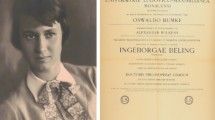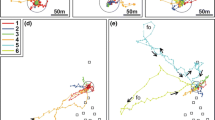Summary
Experiments with two species of honey bees (Apis mellifera andA. cerana) have revealed that bees form a detailed memory of the spatial and temporal pattern of the sun's azimuthal movement, using local landmarks as a reference for the learning. These experiments were performed on overcast days, and consisted of removing a hive from one site in which bees had been trained to find food by flying along a prominent landmark, and displacing it to a similar site in which the landmark was aligned in a different compass direction. On overcast days, bees which flew along the landmark in the new site oriented their waggle dances in the hive as if they had actually flown in the training site. Thus, they confused the two sets of landmarks and set their dance angles according to a memory of the sun's position relative to the original landmarks. Furthermore, the dances changed in correspondence with the sun's azimuthal shift over several hours, even reflecting (approximately) the regular temporal variations in the rate of shift; such features of the sun's course must therefore be stored in memory. The primary mechanism underlying the learning of this pattern is probably similar to that proposed by New and New (1962): bees store in memory several time-linked solar azimuthal positions relative to features of the landscape, and refer to this stored array when they need to determine an unknown azimuth intermediate between two known positions.
During the cloudy-day displacement experiments, celestial cues often appeared to bees in the new site, contradicting the stored information on which they had been basing their dances. Although most bees quickly adopted the dance angle reflecting their actual direction of flight relative to the sun, some later reverted to the original dance angle, indicating that the information on which it was based had remained in memory when the new information was being expressed; other bees performed bimodal dances which expressed both sets of information in alternate waggle runs. The separation in memory implied by these behaviors may reflect a neural strategy for updating a previously stored relationship between celestial and terrestrial references with new information presented by seasonal changes in the sun's course or by newly learned landmarks.
Similar content being viewed by others
References
Batschelet E (1981) Circular statistics in biology. Academic Press, New York
Beier W, Lindauer M (1970) Der Sonnenstand als Zeitgeber für die Biene. Apidologie 1:5–12
Dyer FC (1985a) Nocturnal orientation of the Asian honey beeApis dorsata. Anim Behav 33:769–774
Dyer FC (1985b) Mechanisms of dance orientation in the Asian honeybeeApis florea. J Comp Physiol A 157:183–198
Dyer FC, Gould JL (1981) Honey bee orientation: a backup system for cloudy days. Science 214:1041–1042
Dyer FC, Seeley TD (1987) Orientation and foraging in honey bees. In: Goldsworthy G, Wheeler C (eds) Insect flight. CRC Press, Fort Lauderdale (in press)
Frisch K von (1967) The dance language and orientation of bees. Belknap/Harvard, Cambridge, Massachusetts
Frisch K von, Lindauer M (1954) Himmel und Erde in Konkurrenz bei der Orientierung der Bienen. Naturwissenschaften 41:245–253
Frisch K von, Lindauer M, Schmiedler F (1960) Wie erkennt die Biene den Sonnenstand bei geschlossener Wolkendecke? Naturwiss Rundsch 169–172
Gould JL (1976) The dance-language controversy. Q Rev Biol 51:211–244
Gould JL (1980) Sun compensation by bees. Science 207:545–547
Gould JL (1982) Why do honey bees have dialects? Behav Ecol Sociobiol 10:53–56
Gould JL (1984a) Natural history of honey bee learning. In: Marler P, Terrace HS (eds) The biology of learning. Springer, Berlin Heidelberg New York, pp 149–180
Gould JL (1984b) Processing of sun-azimuth information by honey bees. Anim Behav 32:149–152
Gould JL, Dyer FC, Towne WF (1985) Recent progress in the study of the dance language. In: Hölldobler B, Lindauer M (eds) Experimental behavioural ecology. Fischer, Stuttgart New York (Fort Zool 31), pp 141–161
Koeniger N, Koeniger G (1980) Observations and experiments on migration and dance communication ofApis dorsata in Sri Lanka. J Apic Res 19:21–34
Lindauer M (1956) Über die Verständigung bei indischen Bienen. Z Vergl Physiol 38:521–557
Lindauer M (1959) Angeborene und erlernte Komponenten in der Sonnenorientierung der Bienen. Z Vergl Physiol 42:43–62
Lindauer M (1963) Kompaßorientierung. Ergeb Biol 26:158–181
New DAT, New JK (1962) The dances of honey bees at small zenith distances of the sun. J Exp Biol 39:271–291
Renner M (1957) Neue Versuche über den Zeitsinn der Honigbiene. Z Vergl Physiol 40:85–118
Renner M (1959) Über ein weiteres Versetzungsexperiment zur Analyse des Zeitsinnes und der Sonnenorientierung der Honigbiene. Z Vergl Physiol 42:449–483
Seeley TD, Seeley RH, Akratanakul P (1982) Colony defense strategies of the honey bees in Thailand. Ecol Monogr 52:43–63
Wehner R (1982) Himmelsnavigation bei Insekten. Neurophysiologie und Verhalten. Neujahrsbl Naturforsch Ges Zürich 184:1–132
Wehner R (1984) Astronavigation in insects. Annu Rev Entomol 29:277–298
Wehner R, Lanfranconi B (1981) What do the ants know about the rotation of the sky? Nature 293:731–733
Wehner R, Rossel S (1985) The bee's celestial compass: a case study in behavioural neurobiology. In: Hölldobler B, Lindauer M (eds) Experimental behavioural ecology. Fischer, Stuttgart New York (Fort Zool 31), pp 11–53
Author information
Authors and Affiliations
Rights and permissions
About this article
Cite this article
Dyer, F.C. Memory and sun compensation by honey bees. J. Comp. Physiol. 160, 621–633 (1987). https://doi.org/10.1007/BF00611935
Accepted:
Issue Date:
DOI: https://doi.org/10.1007/BF00611935




